Are you looking to purchase the best CDN for your video streaming but confused about which one you should choose? Recently, one of my friends came to me for a Video CDN recommendation. As I run quite a few blogs where I publish lots of videos, I suggested a few CDNs to him based on his requirements.
If you’re in similar circumstances and looking for a Video CDN that fits your needs, then you’re at the right place. Here in this guide, I’m going to share the list of top CDNs that you can consider for your video streaming needs. These CDNs have been carefully evaluated based on their performance, reliability, pricing, and features.
So, let’s get started…



Top CDN for Video Streaming
Choosing the right CDN for video streaming can significantly enhance your content delivery and viewer experience.
From here, I’ll begin sharing my recommendations on the top CDN options for video streaming. Stay tuned for an in-depth look at each service, their distinct features, and how they could potentially elevate your video streaming capabilities.
Let’s start with my recommendations…
1. BunnyCDN
BunnyCDN has proven itself to be more than just a reliable choice for a Video CDN – it’s my personal choice as well. I use BunnyCDN extensively for most of my video blogs & usual blogs, including this one.

BunnyCDN’s performance and affordability make it an excellent solution not only for streaming video content but also for delivering images and other forms of content. It’s a comprehensive solution that has consistently delivered outstanding results.
One of the standout features of BunnyCDN is its automatic video optimization. The platform adapts the video quality based on the viewer’s connection speed, resulting in a smooth playback experience with minimal buffering. This feature is particularly beneficial for businesses targeting audiences with varying internet speeds.
Another advantage of BunnyCDN is its straightforward pricing model. The platform offers affordable plans with no hidden fees, making it an attractive option for businesses of all sizes. Additionally, BunnyCDN provides detailed analytics and real-time reporting, allowing you to monitor your video streaming performance and make data-driven decisions.
However, it’s worth noting that while BunnyCDN excels in simplicity and affordability, it may lack some of the advanced features offered by more expensive CDN providers.
- Global Coverage: Fast content delivery worldwide.
- Scalability: Handles varying levels of demand with ease.
- Cost-Effective: Pay only for the bandwidth you use.
- Feature-Rich: Offers a suite of useful features.
- Setup: Can be challenging for beginners.
2. Gcore
Gcore Streaming Platform, supported by Gcore’s own global CDN network, enables scaling to over 100 million viewers and optimizes performance within minutes rather than months. It spans all stages of the content delivery process, encompassing video capturing, conversion, media content management, delivery, and playback.

Why opt for Gcore’s CDN network for streaming?
- Truly global coverage with 160+ Points of Presence (PoPs)
- Free adaptive bitrate for swift and seamless video content delivery
- Buffering mitigation, especially important for end users with unstable internet connections
Gcore Streaming Platform also offers:
- Built-in anti-DDoS and WAF protection, guaranteeing both high availability and concurrency
- Free video encoding
- Unlimited VOD storage
- Real-time video and group video calls with branded customization
- Utilization of AI and machine learning for object recognition, VOD, and live video processing.
Gcore’s streaming services are adaptable to individual customer requirements, with bespoke experience tailored upon request. The pricing model for the Gcore Streaming Platform adopts a competitive pay-as-you-go approach, so users only pay for the services they use.
- Extensive Global Coverage: Large network of data centres & fast content delivery worldwide.
- Scalability: Handles varying levels of demand with ease.
- Cost-Effective: Pay only for the bandwidth you use and no long-term commitments
- Feature-Rich: Offers a suite of useful features.
- Adaptive bitrate streaming
Auto-scaling by default
- Free trial plan limitations may necessitate reaching out to Customer support for advanced features
3. Gumlet
Gumlet is a unique CDN provider that offers a multi-CDN solution for video streaming. By partnering with multiple CDN providers, Gumlet ensures high availability and optimal performance for your viewers, regardless of their location.

One of the innovative features of Gumlet is its intelligent routing technology. The platform uses advanced algorithms to route your video content through the best-performing CDN at any given time. This means your viewers always experience the fastest and most reliable streaming, even during peak traffic hours.
Gumlet also offers a range of optimization features, such as automatic video compression and resizing. These features help reduce bandwidth usage and improve loading times, without compromising on video quality.
However, it’s worth considering that managing a multi-CDN setup may require more technical expertise compared to using a single CDN provider. Gumlet aims to simplify this process, but it’s still a factor to keep in mind.
- Adaptive bitrate streaming
- Auto-scaling by default
- Multi-CDN ensures global coverage
- None found
4. KeyCDN
KeyCDN is a reliable and affordable CDN provider that has been serving the video streaming industry for several years. With its global network of servers and straightforward pricing model, KeyCDN is an excellent choice for businesses looking for a cost-effective solution.
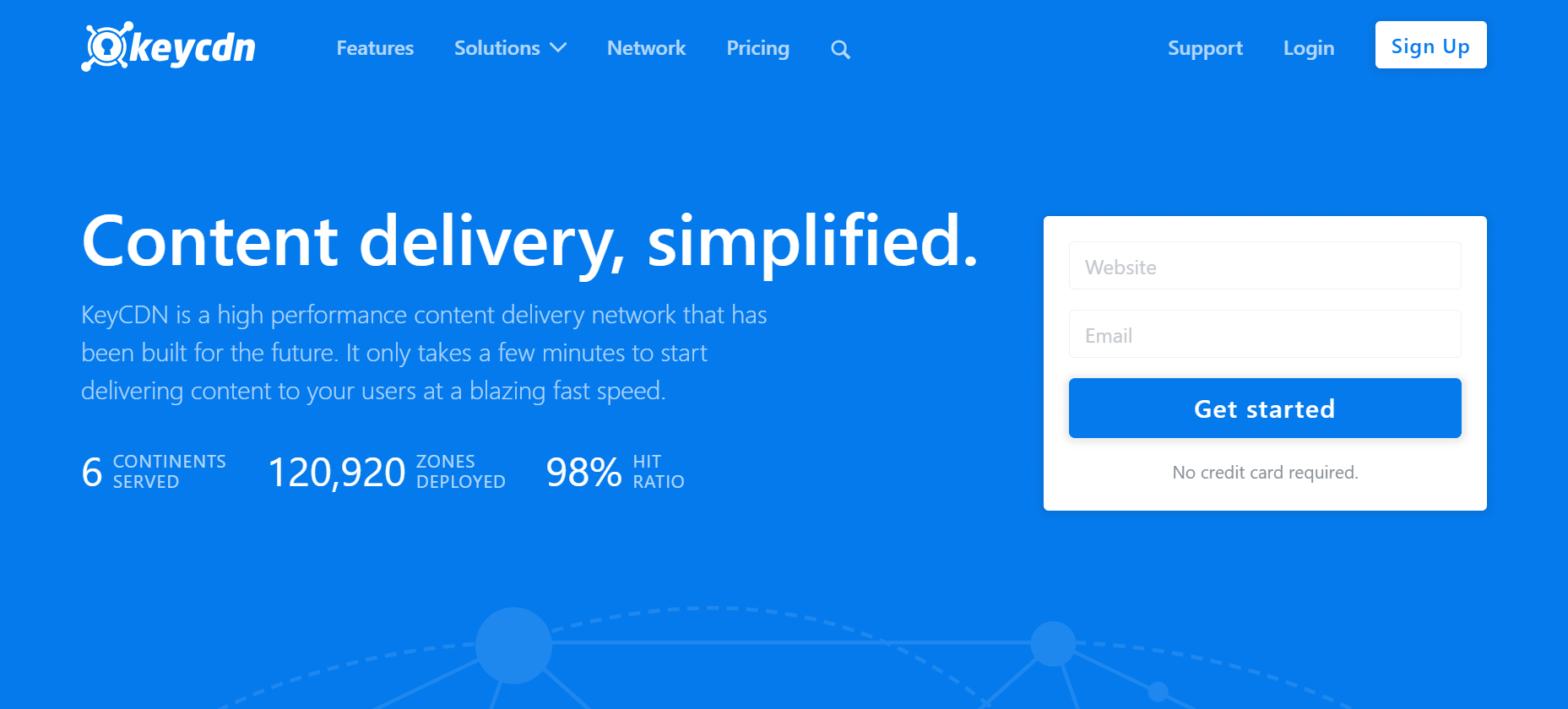
One of the standout features of KeyCDN is its focus on simplicity. The platform offers an easy-to-use interface and a clear pricing structure with no hidden fees. This makes it simple for businesses to budget for their video streaming needs without any surprises.
KeyCDN also provides a range of useful features, such as real-time analytics, custom SSL certificates, and support for various video formats. These features enable you to deliver high-quality video content securely and efficiently.
- Extensive global coverage with a large network of data centers.
- Supports a wide range of video and audio formats.
- Advanced security with Secure Token and hotlink protection.
- Cost-effective with pay-as-you-go and no long-term commitments.
- Minimum payment could be a barrier for smaller websites
5. Amazon CloudFront
Amazon CloudFront is a powerful CDN solution backed by the extensive infrastructure of Amazon Web Services (AWS). With its seamless integration with other AWS services and global reach, CloudFront is a popular choice among businesses of all sizes.
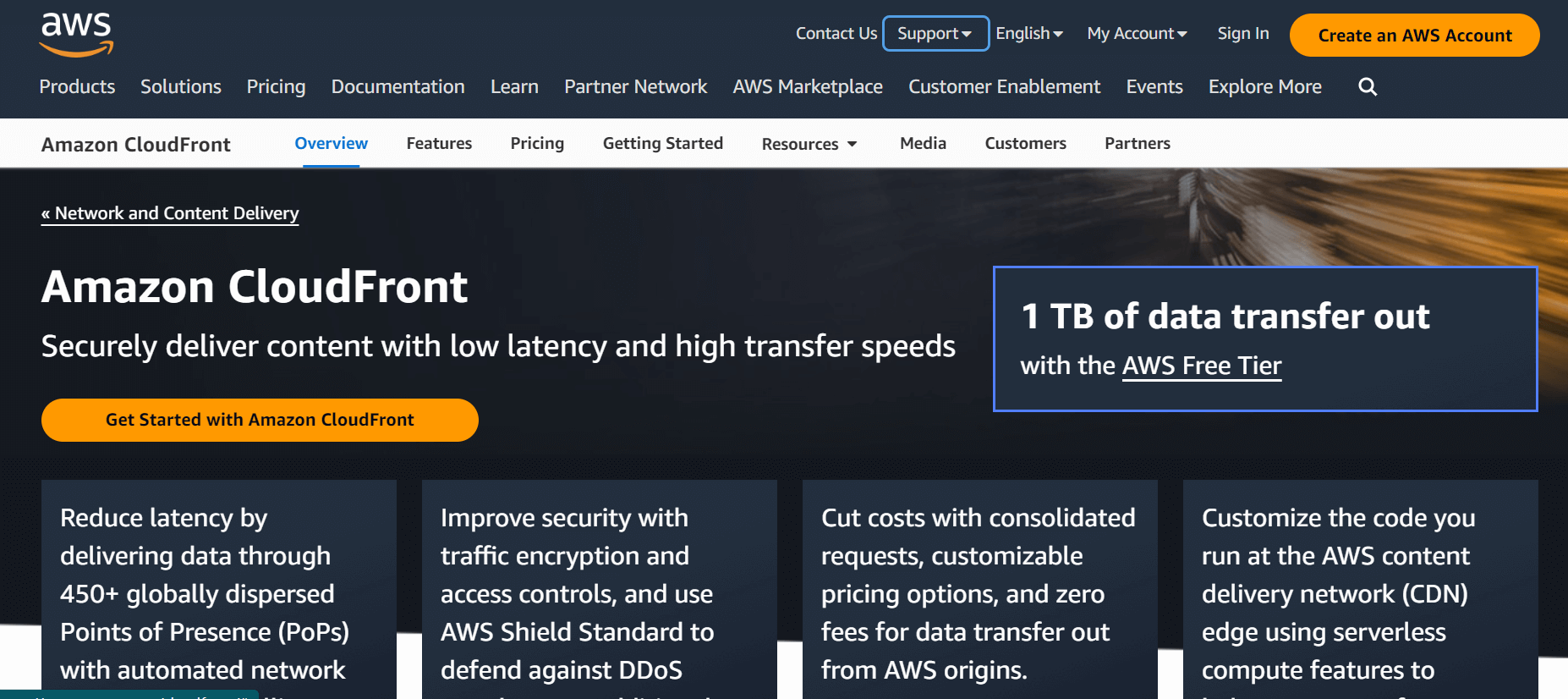
One of the key advantages of using CloudFront is its scalability. The platform can handle sudden spikes in traffic without compromising on performance, making it ideal for businesses with fluctuating video streaming demands.
CloudFront also offers advanced security features, such as AWS Shield for DDoS protection and AWS WAF for application-level security. These features ensure that your video content is protected against potential threats.
Another benefit of using CloudFront is its deep integration with other AWS services, such as Amazon S3 for storage and AWS Lambda for serverless computing. This allows you to build a comprehensive video streaming architecture within the AWS ecosystem.
However, it’s worth noting that while CloudFront offers a wide range of features and scalability, it may require more technical expertise to set up and manage compared to some other CDN providers.
- Robust security against cyber threats.
- Precise viewer access control.
- Scalable and cost-effective storage.
- Fast global content delivery.
- May incur higher costs at scale.
6. Fastly
Fastly is a leading CDN provider known for its speed, reliability, and advanced features. With its edge cloud platform and real-time content purging, Fastly has become a preferred choice for businesses with mission-critical video streaming needs.
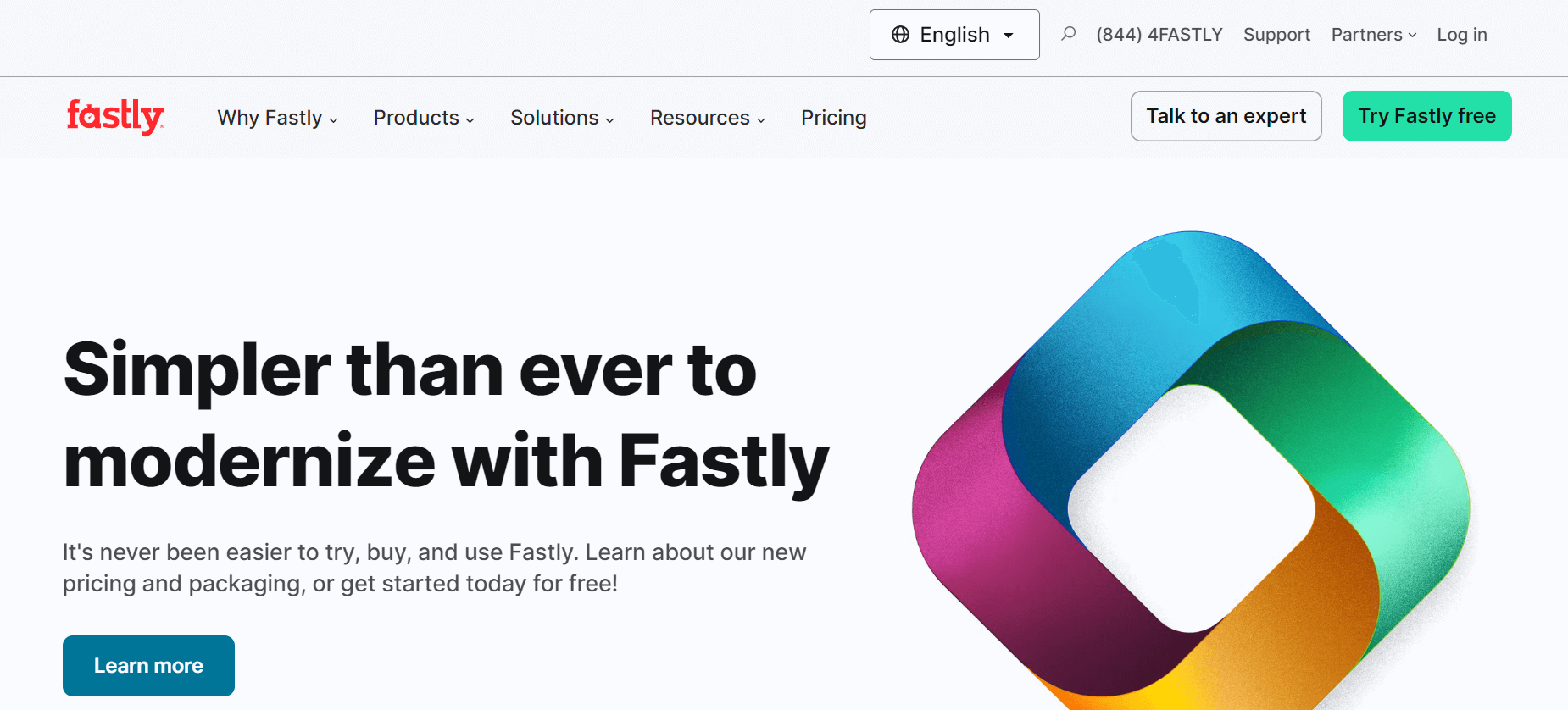
One of the standout features of Fastly is its instant purge capability. This allows you to remove outdated or unwanted content from the CDN cache instantly, ensuring that your viewers always have access to the latest version of your videos.
Fastly also offers a highly customizable edge cloud platform, enabling you to run custom code and logic at the network edge. This opens up a world of possibilities for personalized video experiences and dynamic content delivery.
Additionally, Fastly provides a range of security features, such as DDoS mitigation and SSL/TLS encryption, to safeguard your video content and viewer data.
And here’s something interesting for my readers: Gumlet, which I’ve put in second place on our list, relies on Fastly for its video delivery too. This just goes to show how trusted Fastly is in the video streaming world.
- Real-time configuration changes
- Scalable network with high capacity
- Cost-effective bandwidth usage
- Advanced security features
- Can be complex for beginners
7. Cloudflare CDN
Cloudflare CDN is a popular and versatile CDN solution that offers a wide range of features for video streaming. With its global network and focus on performance and security, Cloudflare CDN has become a trusted choice for businesses of all sizes.

One of the standout features of Cloudflare CDN is its extensive network coverage. With data centers in over 200 cities worldwide, Cloudflare ensures fast and reliable video delivery to viewers, regardless of their location.
Cloudflare CDN also offers advanced security features, such as DDoS protection, SSL/TLS encryption, and web application firewall (WAF). These features help protect your video content and infrastructure against potential threats.
Another advantage of using Cloudflare CDN is its ease of use and integration. The platform offers a user-friendly interface and a wide range of APIs and tools for developers, making it simple to integrate Cloudflare CDN into your existing video streaming workflow.
Additionally, Cloudflare CDN provides a flexible and cost-effective pricing model, with plans that cater to businesses of various sizes and needs.
- Expansive global Anycast network for rapid video delivery
- Adaptive bitrate streaming for optimal viewer experience
- Robust security features integrated with CDN services
- Advanced business logic at the network edge for custom configurations
- Free plan limitations may necessitate upgrades for advanced features
- Some users report challenges with cache management
8. Google CDN
Google Cloud CDN is a powerful and reliable CDN solution that leverages Google’s extensive global infrastructure. With its seamless integration with Google Cloud Platform (GCP) services and advanced caching capabilities, Google Cloud CDN is an attractive choice for businesses already using GCP.

One of the key advantages of using Google Cloud CDN is its ability to cache content at the edge of Google’s network, closer to the users. This reduces latency and improves the overall streaming experience for viewers worldwide.
Google Cloud CDN also offers a range of optimization features, such as HTTP/2 and SSL/TLS support, to enhance the performance and security of your video content.
Another benefit of using Google Cloud CDN is its integration with other GCP services, such as Google Cloud Storage for content storage and Google Cloud Load Balancing for efficient content delivery.
However, it’s worth noting that while Google Cloud CDN offers a powerful and reliable solution, it may require more technical expertise to set up and manage compared to some other CDN providers, especially for businesses not already familiar with GCP.
- Extensive coverage with worldwide Points of Presence (POPs)
- User-friendly interface for ease of use
- Strong security features and a reputable brand
- Seamless integration with other Google services
- Costs can escalate with increased bandwidth usage
- Some limitations in control over content delivery configurations.
9. Microsoft Azure CDN
Microsoft Azure CDN is a reliable and scalable CDN solution that leverages the global infrastructure of Microsoft Azure. With its seamless integration with Azure services and developer-friendly features, Azure CDN is a popular choice for businesses already using the Azure platform.
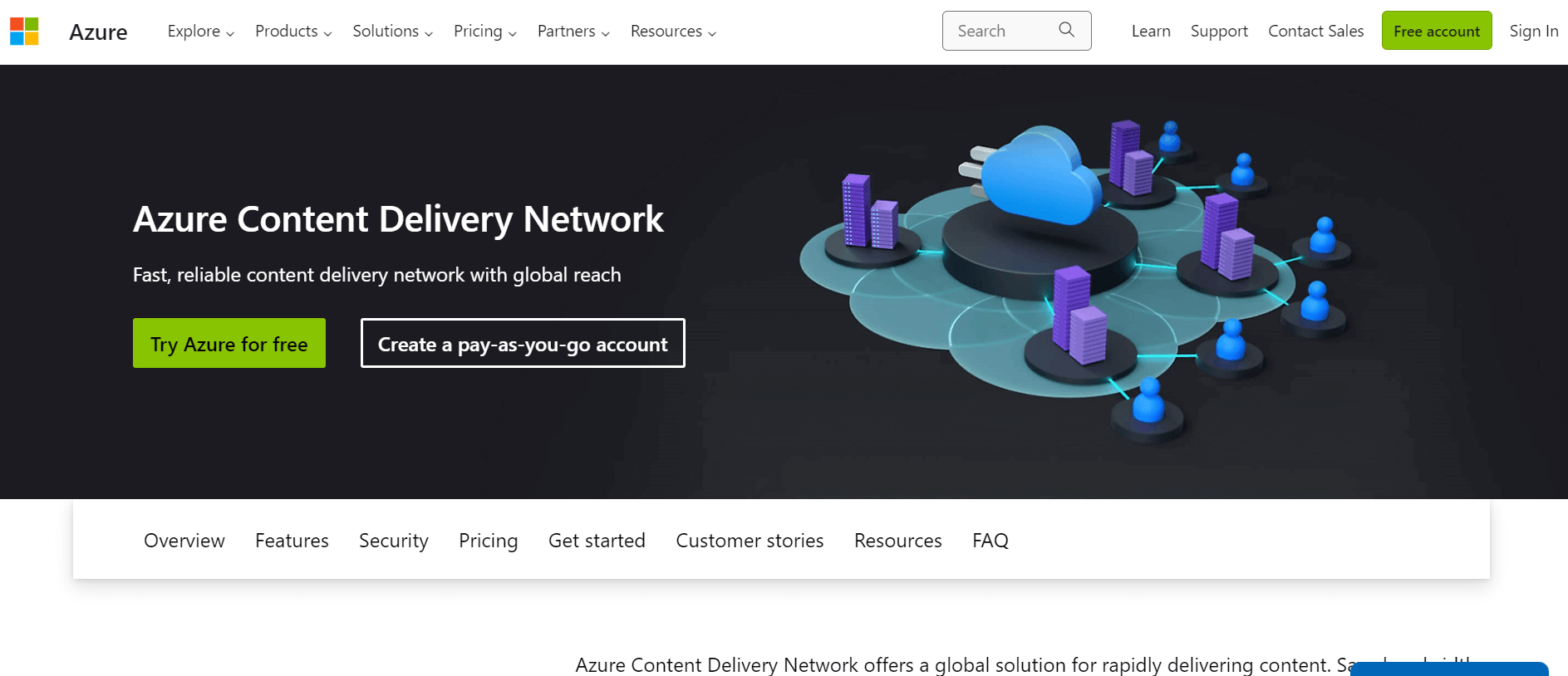
One of the key benefits of using Azure CDN is its tight integration with other Azure services, such as Azure Media Services for video encoding and Azure Storage for content storage. This allows you to build a comprehensive video streaming workflow within the Azure ecosystem.
Azure CDN also offers a range of optimization features, such as dynamic site acceleration and image optimization, to enhance the performance of your video content.
Additionally, Azure CDN provides a developer-friendly environment, with support for popular programming languages and tools. This makes it easier for developers to integrate Azure CDN into their existing workflows.
However, it’s important to consider that while Azure CDN offers a seamless experience for businesses already using Azure, it may require more technical expertise to set up and manage compared to some other CDN providers.
- Extensive global network ensures fast video delivery worldwide.
- Capable of handling large video files and high-content videos efficiently.
- Pay-as-you-go pricing model can be cost-effective for controlled usage.
- Offers a $200 credit for new sign-ups, providing a cost buffer for initial use.
- Known for being secure, stable, and user-friendly after initial setup.
- Costs can be high, potentially making it less suitable for small-scale bloggers or startups.
- The learning curve for initial setup and management can be steep for beginners.
- Pay-as-you-go model requires careful monitoring to avoid unexpected costs.
10. Akamai
Akamai is a well-established CDN provider with a long history of delivering high-quality video streaming experiences. With its extensive global network and advanced optimization tools, Akamai has earned the trust of many large enterprises and media companies.
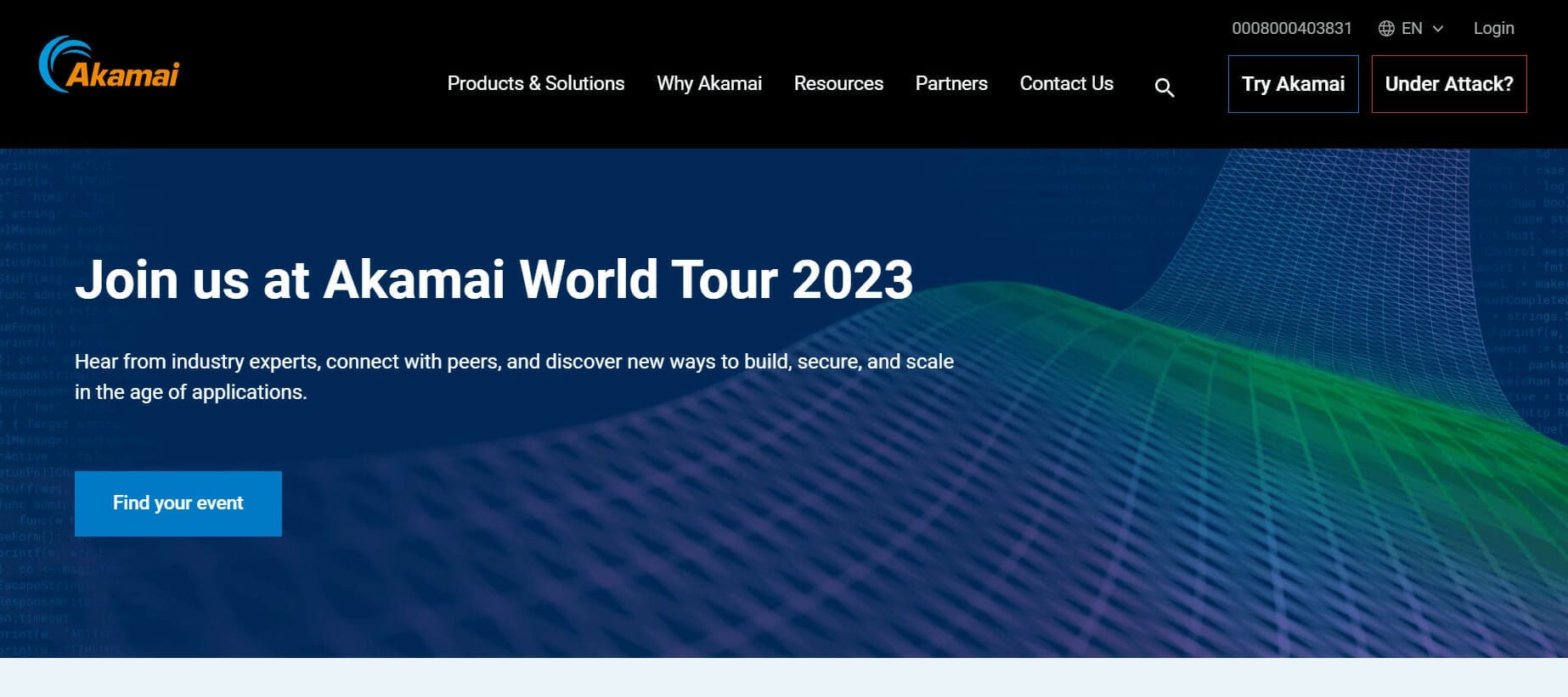
One of the key strengths of Akamai is its advanced video optimization capabilities. The platform offers features like adaptive bitrate streaming, which adjusts the video quality based on the viewer’s connection speed, and dynamic transcoding, which converts video files into various formats and resolutions on the fly.
Akamai also provides robust security features, such as DDoS protection, bot management, and access control. These features ensure that your video content is protected against potential threats and unauthorized access.
Another advantage of using Akamai is its global reach. With servers in over 130 countries, Akamai can deliver your video content to viewers around the world with minimal latency.
However, it’s worth noting that Akamai’s pricing may be higher compared to some other CDN providers, due to its extensive feature set and enterprise-grade support.
- Fast video and image loading.
- High-quality 4K and HD support.
- Advanced image optimization tools.
- Strong cybersecurity measures.
- Customizable service plans.
- User-friendly with seamless integration.
- Higher cost than average CDNs.
- Complexity for new users.
- Custom pricing may be unpredictable.
Frequently Asked Questions (FAQs)
Q. What is a video CDN?
A video CDN is a specialized type of Content Delivery Network designed to optimize the delivery of video content. It uses a distributed network of servers to provide high-quality streaming with reduced buffering and latency.
Q. How does a video CDN improve streaming quality?
A video CDN delivers content from the closest server to the user, which reduces the distance the data travels, minimizing latency and buffering, and supports adaptive bitrate streaming for optimal quality.
Q. Can a video CDN handle live streaming events?
Yes, video CDNs are equipped to handle live streaming. They can manage large spikes in traffic and audience size, ensuring smooth delivery of live content without overwhelming the origin server.
Q. Is a video CDN cost-effective for small businesses?
A video CDN can be cost-effective for businesses of all sizes as it can reduce infrastructure and bandwidth costs, and pricing plans can be scalable based on the company’s needs and traffic demands.
Q. Does using a video CDN improve website SEO?
While a video CDN doesn’t directly affect SEO, the improved site speed and user experience can contribute to better engagement metrics, which are favorable for SEO rankings.
Wrapping Up!
Choosing the right CDN provider for your video streaming needs is a critical decision that can significantly impact the success of your business. By considering factors such as performance, security, pricing, and global reach, you can select a CDN provider that aligns with your specific requirements.
In this comprehensive guide, we have explored the top 10 CDN providers for video streaming in 2025. Each provider has its own strengths and weaknesses, and the best choice for your business will depend on your unique needs and budget.
Whether you prioritize affordability and simplicity, like with BunnyCDN and KeyCDN, or require advanced features and extensive customization options, like with Fastly and Akamai, there is a CDN provider that can meet your video streaming needs.
My advice is to carefully evaluate your requirements, consider the long-term scalability of your chosen solution, and don’t hesitate to reach out to the CDN providers for more information or a custom quote.
